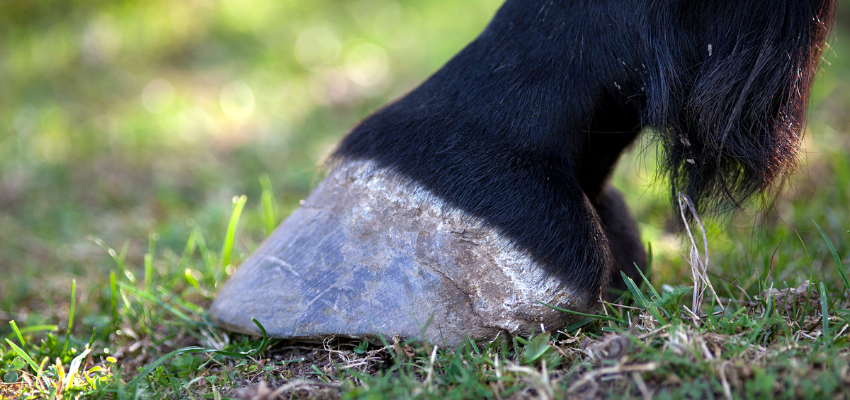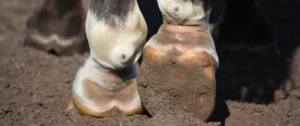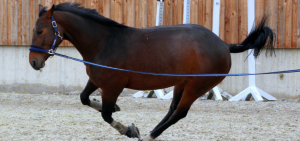Laminitis is one of the most painful diseases in horses. In some cases, it can even become chronic. But what exactly is laminitis? In this article, you will learn everything you need to know: from the causes and symptoms of laminitis to diagnosis and treatment, to preventive measures and chances of recovery.
What exactly is Laminitis?
Laminitis is an inflammation of the hoof in the area of the toe wall. Swelling occurs when the hoof dermis is inflamed and blood circulation is disrupted. However, this swelling cannot spread under the hard horny capsule. This creates high, very painful pressure.
If the inflammation isn’t recognized and treated in time, the horse’s hoof won’t be supplied with the nutrients it needs due to circulatory problems. This can cause the horn capsule to become loose from the coffin bone, which can lead to rotation and lowering of the coffin bone. Eventually, the coffin bone can break through the sole. In addition, slipping can occur. This means the complete loss of the horn capsule. This is very painful for the horse. In severe cases that result in shoe slipping, it may be necessary to consider relieving the horse of its pain and putting it to sleep.
Causes of Laminitis in horses
There hasn’t been enough research to determine the exact causes of laminitis. However, the following factors can play a role:
Food-related Laminitis
Improper feeding is the most common cause of laminitis. For a long time, it was assumed that food containing too much protein was a trigger for laminitis in horses. Now, it’s known that too much sugar and starch in the food is a problem. For example, concentrates contain starch from oats, barley, and corn. Sugar is often found in grass and hay in the form of the polysaccharide fructan.
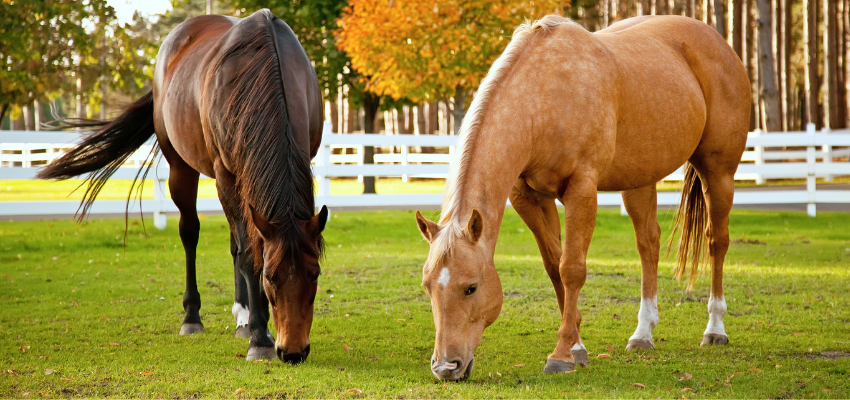
If the horse consumes too large amounts of sugar and starch, the stomach and small intestine are unable to fully digest them. This causes undigested remains to enter the large intestine, however, the large intestine cannot process large amounts of fructans. This upsets the balance of bacteria in the colon. This in turn changes the pH value in the intestine, which results in the death of good intestinal bacteria. This creates toxins that enter the bloodstream. This causes the horse’s entire organism to slowly become acidic. This reduces blood circulation in the hoof and can trigger laminitis.
Grazing for sensitive horses
In the case of laminitis caused by feeding, sugar is the most common cause of laminitis in horses, such as the polysaccharide fructan. As mentioned above, excessive fructan feeding can promote laminitis in horses. Pasture grass has increased quantities of Fructan. However, the fructan content in grass is not always the same but varies greatly throughout the day. Only turn out horses that are susceptible to laminitis to pasture when fructan levels in the grass are low.
The amount of fructan contained in pasture grass depends on various factors, including the intensity of sunlight, temperature, time of day, and type of plant. If the sun is shining and it is warm, the plant grows and contains little fructan. If the sun is shining and it is cold, the plant also carries out photosynthesis. However, if the plant only grows little or not at all, the energy produced is stored as fructan. This table shows you when the risk of laminitis from fructan is highest:
| Risk | Weather | Plant growth |
| Very low risk | Warm, humid weather with overcast skies | Little energy production, increased growth, depletion of fructan stores |
| Low risk | Warm, dry weather with overcast skies | Little energy production, low growth |
| Medium risk | Warm, dry weather with sunshine | Slightly increased energy production, slightly increased fructan storage, low growth |
| High risk | Cold, frosty, dry weather with overcast skies | Increased energy production, increased fructan storage, no growth |
| Very high risk | Cold, frosty, dry weather with sunshine | Very high energy production, very high fructan storage, no growth |
Overweight
If a horse is overweight, this represents another risk factor that can promote laminitis. On the one hand, excess weight puts strain on the entire hoof mechanism. On the other hand, fat is responsible for the production of hormones. This can disrupt the sugar and insulin metabolism, which can trigger laminitis in the horse.
Metabolic Laminitis
Horses with metabolic diseases, such as Cushing’s syndrome or equine metabolic syndrome (EMS), can often present with laminitis as a comorbidity.
Equines Cushing Syndrom (ECS)
Laminitis can often occur as a result of Cushing’s syndrome. Cushing’s syndrome is caused by a slowly growing benign tumor in the pituitary gland. This is responsible for the release of the hormone ACTH. The tumor causes your horse’s body to produce more cortisol. This influences, among other things, your horse’s metabolism, cardiovascular system, and blood sugar level. Too much sugar in the blood leads to the narrowing of the blood vessels and hyperacidity, including in the hooves.
Equines Metabolisches Syndrom (EMS)
EMS is a carbohydrate metabolism disorder. The cause of EMS is often incorrect feeding. The metabolic disorder caused by this disease leads to increased production of insulin, which can trigger laminitis in the horse.
Stress
Regular loading and unloading of the hooves is essential for good blood circulation in the horse’s hooves. Too much strain leads to a circulatory disorder, which can cause the hoof dermis to become inflamed. This can be caused by long periods of walking or standing on stony or hard ground, such as asphalt. If your horse rests one leg due to lameness, his weight will be placed more on the other three legs, which can lead to severe strain. This overload can also trigger stress laminitis. In addition, incorrect processing of the hooves, which results in unphysiological stress, can also lead to stress.
On our website, Linda Tellington Jones shows you how to help your horse reduce stress and promote relaxation using the world-famous TTouches.
Poisoning
When a poison is ingested, the intestines absorb the toxins. These reach the horse’s hoof dermis via the blood. Poisoning deer can result from ingesting poisonous plants, such as ragwort, robinia, acorns, or St. John’s wort. Pesticides, molds, or fungal spores can cause poisoning. It can also happen that vaccinations, worming treatments, or other medications are the cause of a poisoning.
Lyme Disease
A horse bitten by a tick can transmit Lyme disease. Lyme disease can in turn trigger inflammation of the hoof skin and cause laminitis.
Can any horse get laminitis?
In principle, any horse can suffer from laminitis. However, research has shown that light-fed and overweight horses are more prone to laminitis.
How do I recognize Laminitis?
When it comes to laminitis, there are three different stages; the precursor stage, acute, and chronic laminitis. Depending on the stage, there are different and varying degrees of symptoms.
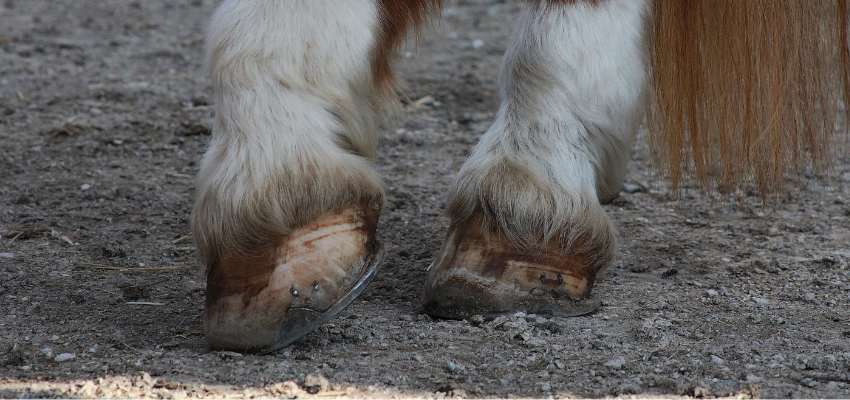
Laminitis symptoms in the beginning stages
The precursor stage is a slight inflammation of the hoof dermis. However, the symptoms of mild laminitis are often difficult to recognize. However, these signs can indicate this:
- Alternating lifting and lowering of the affected hooves
- Reluctance to pick up hooves
- Slight lameness at walk and trot
- The horse runs sensitively and in a tight manner, especially on hard ground, and prefers to stand on soft ground
- The horse finds it difficult to make tight turns
- Slight pain reaction during the forceps test, although this reaction is often not clearly identifiable at such an early stage
- Slight pulsation at the fetlock
- Slightly warmed hooves
Laminitis symptoms in the acute stage
The following symptoms occur if your horse is already suffering from an acute attack:
- Severe pain even when standing
- If the horse’s front legs are affected by laminitis, it stretches them out to relieve the hoof walls. It shifts its weight to its hind legs and the heels are overloaded. This position is known as the so-called sawhorse position.
- If the horse’s hind legs are affected, he will push them under his body
- The horse no longer wants to move
- Frequent shedding
- Clear pain reaction during the forceps test
- Severe lameness
- Throbbing pulsation at the fetlock head
- Warm hooves
- Increase in pulse and breathing rate
- Fever
Laminitis symptoms in the chronic stage
If left untreated, the acute episode of laminitis turns into a chronic episode of laminitis after just 24 to 72 hours. These symptoms can occur or worsen:
- Horse prefers to lie down
- apathy
- Loss of appetite
- Cold hooves due to decreased blood circulation
- Widening of the white line on the sole of the hoof as scar tissue forms in the hoof dermis due to the acute inflammation
- Marked lameness
- Clear pain reaction during the forceps test
- Concave toe wall
- Formation of deer rings
- Formation of a tuberous hoof
- Increase in pulse and breathing rate
- Fever
- Soles can break and slip out of shoes
First aid for Laminitis
If you suspect your horse has laminitis, you should consult your veterinarian as soon as possible. After you’ve done this, you can take the following first-aid measures to relieve your horse’s pain:
- Make sure your horse is standing on soft ground. This way you can sprinkle your horse’s box or shelter thickly.
- Don’t move your horse unnecessarily as every step can cause pain for your horse.
- Cool your horse’s hooves with cold water to relieve his pain. You can use a water hose, place it in a bucket of cold water, or put on a hoof bandage and pour cold water on it.
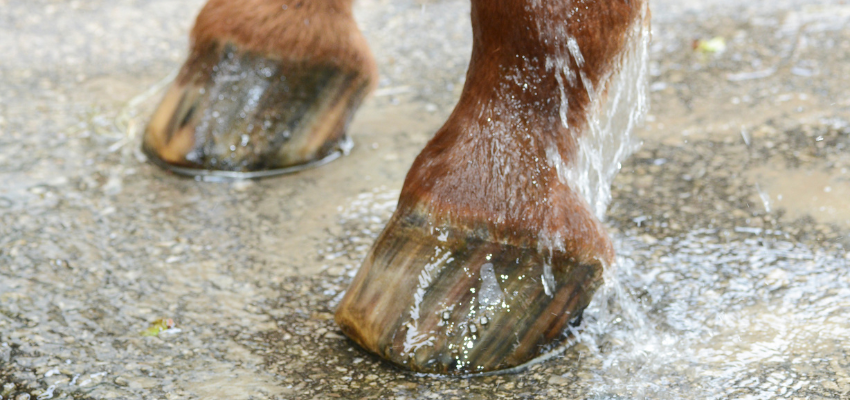
Every horse owner knows how quickly acute illnesses and injuries can occur. However, it can sometimes take a while for the vet to get there. It’s even better if you know what to do and how to provide first aid.
Diagnosis of Laminitis in horses
Laminitis is diagnosed by veterinary examination:
- Lameness examination: A lameness examination is performed first if the horse’s condition allows it.
- Hoof pliers test: The hoof is examined using hoof pliers. However, this procedure only allows a reliable diagnosis to be made in the acute stage.
- X-rays: It is also necessary to X-ray the horse’s hooves. This is the only way to assess the changes in the coffin bone, the horn capsule, and their alignment.

Treatment of Laminitis in horses
The specific treatment for laminitis in horses depends on the extent of the pain and the stage of the laminitis. However, the best results are achieved when treatment begins at the precursor stage. The treatment can look like this:
Fighting inflammation
The inflammation of the hoof dermis must be reduced as quickly as possible to prevent further swelling. If not, it could lead to rotation or lowering of the coffin bone. To do this, the horse is given anti-inflammatory drugs to control the edema of the hoof dermis and reduce the pressure in the hoof.
Vasodilating & blood thinning medications
The horse also receives vasodilator and blood-thinning medication to promote blood flow to the toe.
Relief of the toe wall
If necessary, part of the toe wall can be removed so that the inflammation can drain away. This relieves the toe area and allows the coffin bone and wall to be kept parallel. The hoof can also grow back straight and no bulbous hoof is formed.
In addition, the horse’s hooves are regularly cooled to relieve the pain. With the help of a hoof bandage, the hoof is padded and protected from infections.
How can I prevent Laminitis in horses?
To prevent your horse from getting laminitis in the first place, you can take certain preventive measures. Since incorrect feeding, excess weight and an imbalanced metabolism are the most common causes of laminitis in horses, you should carefully analyze your horse’s feeding and change it if necessary.
The crude fiber content of the feed should be kept high and the starch and sugar content low. The focus of feeding should be on a sufficiently large amount of high-quality hay or haylage. The concentrated feed ration should be adapted to your horse’s needs and workload. We also recommend a needs-based mineral feed that helps your horse’s metabolism stay in balance.
When can I ride again after Laminitis?
You should definitely discuss with your veterinarian when exactly you can start riding after laminitis. However, you can often start riding again after a few weeks or months.
What are the chances of recovery of Laminitis in horses?
The chances of healing from laminitis in horses depend on the individual horse on the one hand and on the stage of laminitis on the other. If the coffin bone hasn’t rotated and lowered, there’s a good chance that the horse can be ridden again. If the coffin bone is strongly rotated or even sunk, there is a risk that the horse can no longer be ridden regularly again. It is also the case that horses that have already suffered from laminitis once have an increased risk of developing it again.
Laminitis in horses is a painful and serious disease that can potentially be life-threatening. Early detection and treatment are crucial to reducing your horse’s suffering and preventing long-term damage. If you notice the first signs of laminitis, don’t hesitate to call your vet as soon as possible.


